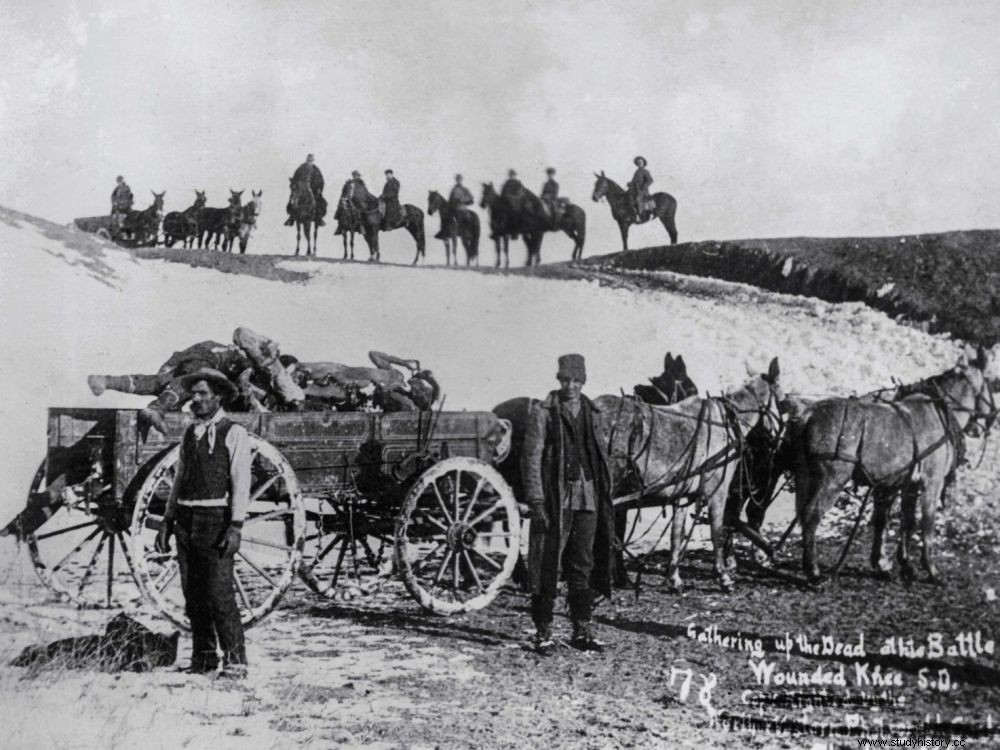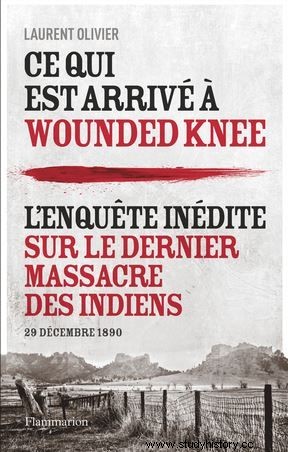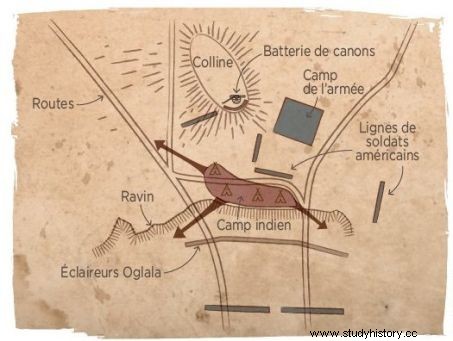In 1890, during a terrible confrontation, more than 300 Lakota Sioux Indians were killed at Wounded Knee by the American army. The archaeologist Laurent Olivier returned to the springs of this drama in a new book.

Lakota Sioux - men, women and children - were massacred after being rounded up at Wounded Knee, South Dakota, to be transferred to Nebraska (here, the bodies picked up at the scene of the tragedy).
MASSACRE. Wounded Knee, where the last massacre of the Indians. In a terrible confrontation, more than 300 Sioux Lakota Indians were killed on December 29, 1890 by the United States army. One of the darkest pages in American history, culminating in a tragedy that began a few days earlier and culminated in the death of the last great Sioux chiefs Sitting Bull and Big Foot with all their tribes, including women and children.

130 years after this tragedy, the historian and archaeologist Laurent Olivier, chief curator of heritage at the National Archeology Museum of Saint-Germain-en-Laye, returns to this tragedy in a book:"What happened to Wounded Knee – The unpublished investigation into the last massacre of the Indians", published by Flammarion, 526 p., €23.90. In November 2011, Sciences et Avenir - La Recherche devoted an article to the research carried out by Laurent Olivier on this tragedy, which we suggest you read again here.
In winter, snow covers the stele. But most of the time, the heat makes the anthracite stone hot. Lost in the middle of the vast plains of South Dakota (United States), it is the only memorial vestige of a tragedy that is still not taught in the school books of young Americans. However, it recalls the greatest massacre perpetrated on United States soil at the end of the 19th century! The Lakota Sioux themselves erected this monument, in 1903, to forever engrave the names of 186 of their dead, shot by soldiers of the 7th US Cavalry Regiment at Wounded Knee ("Wounded Knee") in the heart of the Great Plains , east of the Rocky Mountains. Historians today estimate that more than 300 men, women, children and infants were massacred on the night of December 29, 1890 during what was originally intended to be a population transfer operation. How, precisely, did we arrive at this slaughter?
Confronting the divergent versions in the field
One hundred and thirty years after the events, it is to answer this question that the archaeologist Laurent Olivier, researcher at the CNRS and curator at the National Archeology Museum of Saint-Germain-en-Laye (Yvelines), has just set up a major research project that will begin next year for a duration of three years (this article was originally published on November 15, 2020 on the website of Sciences et Avenir, after publication in the magazine, Ed) . Objective:to study the "crime scene" to confront, on the ground, the divergent versions of the American army and the Lakotas.
"Archaeology now has non-invasive methods that make it possible to locate and identify remains invisible on the surface, explains the specialist . The lidar, for example, makes it possible to detect all the microvariations of the ground, signaling buried structures. And geophysical prospecting reveals concentrations of Buried metal debris (bullets, weapons, etc.) We will thus be able to determine where surveys could be carried out." Laurent Olivier will work in collaboration with local archaeologists and representatives of the Lakota tribes of the Pine Ridge, Rosebud, Cheyenne River and Standing Rock regions. In 2019, during a first trip, this specialist in the Celts was indeed able to meet Tawa Duchenaux, director of the Historical Center of Oglala College in Kyle (South Dakota), as well as Alex White Plume, former president of the Council Oglala Lakota tribe, all enthusiastic about such research. "The history of these groups is close to that experienced by the Gauls who are also peoples of colonized warriors, specifies the archaeologist who thus explains his passion for Indian history. Now we have to make the ground speak."

A stele was erected in 1903 on the site of the mass grave where the victims of the massacre were buried and around which a small cemetery has since developed (GETTY IMAGES).
To understand, we have to go back to the winter of 1890. The Lakota Sioux, on the verge of starvation, then lived entrenched on the last land they had left. But, influenced by a messianic movement spread through a "Ghost Dance" (Ghost Dance ), they are convinced that the whites will soon disappear and the buffalo herds will return. Farmer-settlers, more and more numerous in the region, fear unrest and ask for the support of the army to find the propagators of this rumor. And so it was that on December 28, the 7th American Cavalry Regiment, supported by a battery of four guns, surrounded more than 300 Lakota warriors and their families from the Lakota Miniconjou tribe, coming from Cheyenne River. Among them are about thirty survivors of the tribe of Sitting Bull, the victorious hero of the famous battle of Little Big Horn against General Custer (1876) and the same 7th cavalry regiment, as well as Lakota Hunkpapas coming from the reserve of Pine Ridge. The soldiers - who are 75% novices - gather them on the site of Wounded Knee, with the mission of conveying them by train the next day to the reserve of Omaha (Nebraska), 400 km away. Journalists are present to witness what they call "the surrender of the Sioux" . But just as the soldiers begin to want to disarm the warriors, an incident changes everything.
According to the army - which will produce numerous reports to justify the massacre and the 30 dead that it will count in its ranks - an accidental shooting would be at the origin of the carnage. Where did he come from? Mystery. Still, according to the soldiers, the Lakotas immediately fired, leading to a deadly response. "The veracity of this version remains to be established" , explains Laurent Olivier. Indeed, if the American soldiers really came under heavy enemy fire, the ground surveys should deliver a large quantity of Winchester 73 bullets, the Indians' favorite weapon. On the other hand, if the soldiers, in panic and confusion, launched the offensive against entire families, the ground should be mostly covered with bullets from Springfield regulation rifles, which the examination of the projectiles should establish. "It is also possible that the reconnaissance of the site may hold surprises, for example by revealing the existence of remains whose memory has not been transmitted" , adds Laurent Olivier.
A wound that remains gaping
At the end of the massacre, many human trophies were collected by the soldiers (scalps, braids, etc.) which ended up, over time, in museums or with private collectors. More than 200 of these macabre memories - which can be considered as exhibits - have already been located by the team in museums in the states of Nebraska and Iowa, as well as at the prestigious Smithsonian Institute. , in Washington.

Mass graves where the bodies of the victims of the Wounded Knee (South Dakota) massacre were piled up, in December 1890.
"So-called NAGPRA* legislation, enacted in the 1990s, compels institutions to return ceremonial objects in their possession" , continues the specialist. The preparatory survey also brought to light forgotten links between the Lakota Indians and the European pioneers, particularly French, hidden by the American account of the Conquest of the West:"Very many surnames are of French origin... Many Ducheneaux, Robideau and others Bissonnette are there to remind us how many “coureurs des bois” or trappers from France had settled in the Great Plains between the 17th and 19th centuries, where they had started a family" . All these elements explain why the leaders of the Lakota tribe expect a lot from this archaeological investigation.
"Until the 1940s, the survivors of the massacre and their families tried, in vain, to obtain compensation from the American government. Because this wound remains gaping" , explains Laurent Olivier. Especially since a second drama joined the first at Wounded Knee, that of the protest movement of the American Indian Movement in 1973. For 71 days, to protest against the corruption of the authorities and the brutality of the police of the Pine Bridge reservation, Indians occupied the site where their ancestors had been exterminated and were besieged there by the FBI and the National Guard. This time, their resistance was crowned with a media victory. Many personalities took up their cause.

A member of the American Indian Movement (AIM) at Wounded Knee in 1973. Oglala Sioux Indians and AIM activists occupy this symbolic site - quickly surrounded by the FBI and the National Guard - to protest against corruption and police violence. The siege will last 71 days. (BETTMANN/ GETTY IMAGES)
Admittedly, the situation of the Indians of North America has since improved somewhat, these communities having their own institutions, but they still have to fight for the protection of their sites. In 2019, the Lakotas were faced with the installation of a giant pipeline, which led to the destruction of several of their worship sites. "Wounded Knee is the symbol of a oppression that continues through generations." With this investigation which begins, the Indians see reborn the hope that the American Congress emits something other than simple "regrets".
* In 1990, federal law NAGPRA (The Native American Graves Protection and Repatriation Act) required that unearthed Native American cultural property be returned to indigenous peoples.
BACKGROUND
The Indian Wars are the set of conflicts that pitted European settlers and then successive governments of the United States and Canada against Native American populations between 1778 and 1890. Although none of them was officially declared by the Congress of the United States, the American army was thus at war against the Amerindian peoples during most of the 19th century. Wounded Knee is historically considered the event that ended more than a century of fighting.

(BRUNO BOURGEOIS)
The course of a massacre
In the early morning of December 29, 1890, American troops began the transfer operation of the Sioux Lakotas who were to be conveyed by train to Nebraska. Several companies of cavalry, 50 strong each, surrounded the camp. Oglala scouts and interpreters (one of the 7 Lakota sub-tribes), recruited by the army, assist them. A hundred Lakota warriors (106 men) are then separated from the rest of the group so that they lay down their arms. It was during this maneuver, at the time of disarmament, that an accidental shot was fired, the origin of which remains undetermined to this day. A heavy firefight ensued. The battery of cannons opens fire, killing men, women and children who, panicked, try to flee (brown arrows). Between 300 and 350 Indians are killed during this massacre. Their bodies will be thrown into a pit.

(BRUNO BOURGEOIS)
